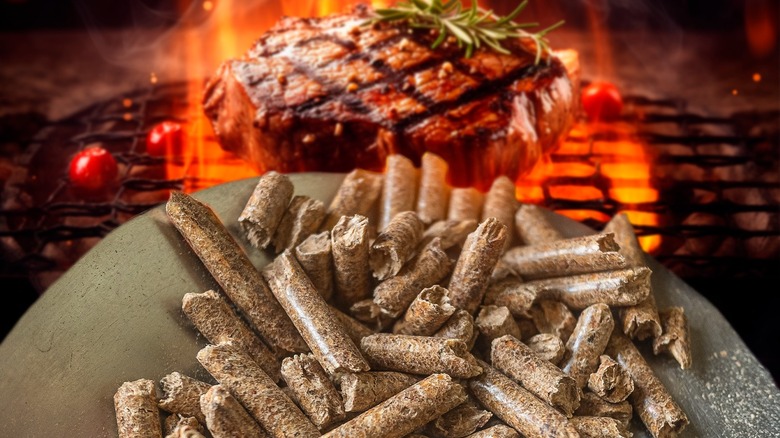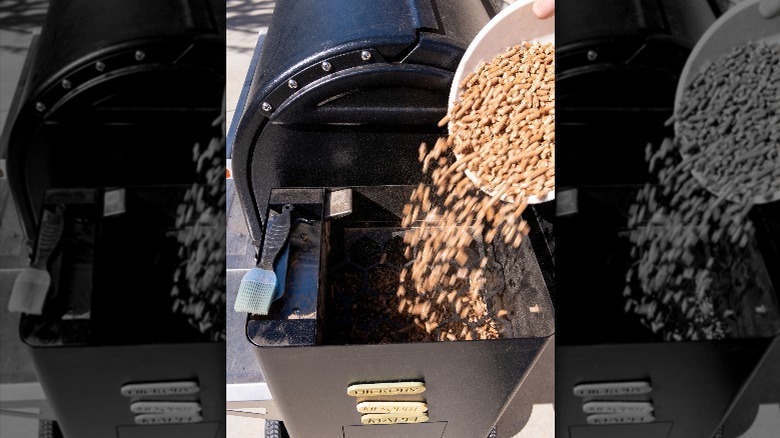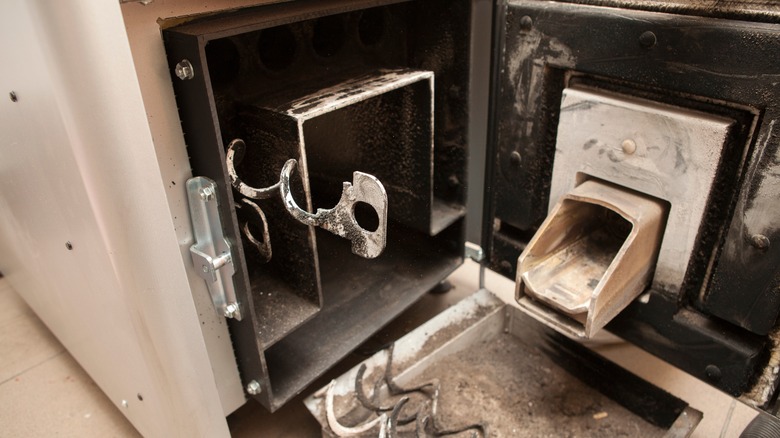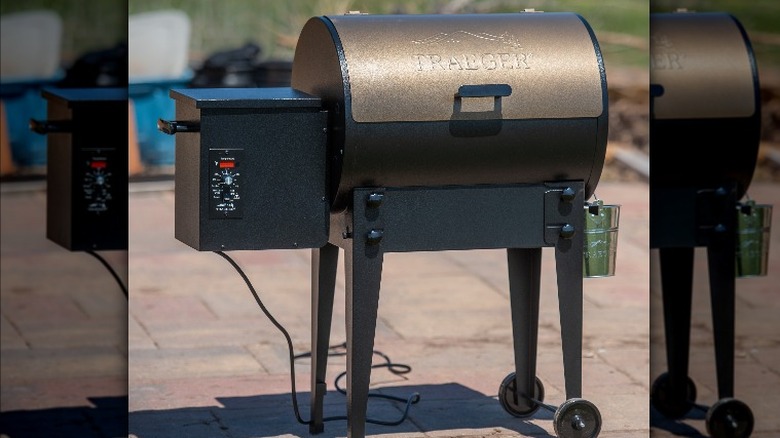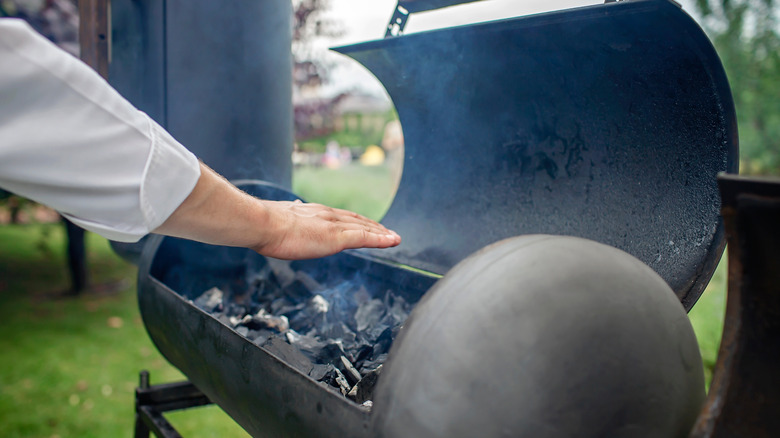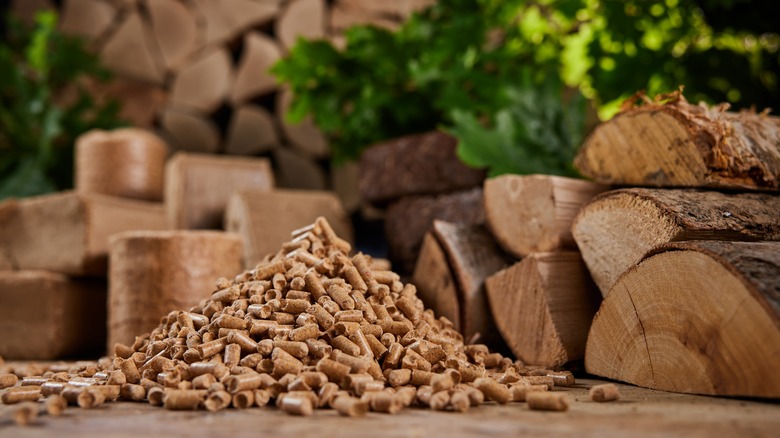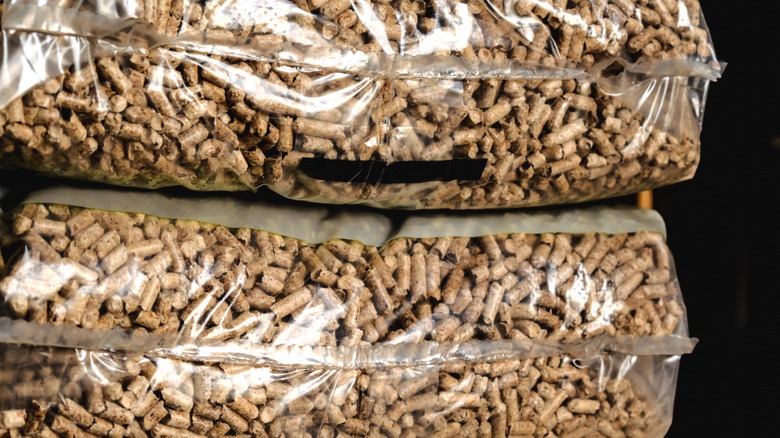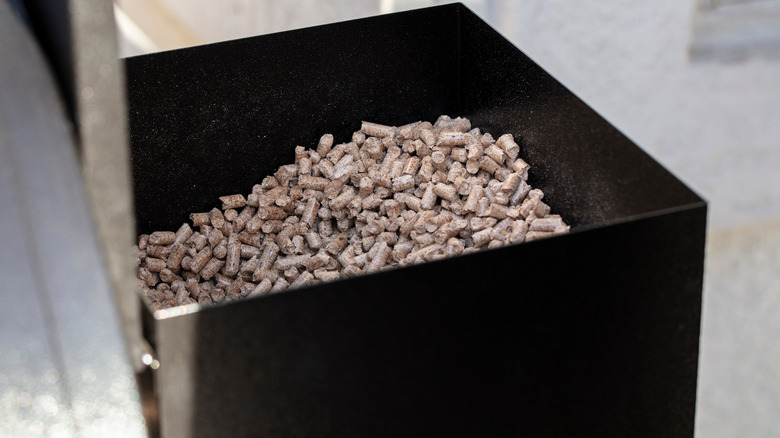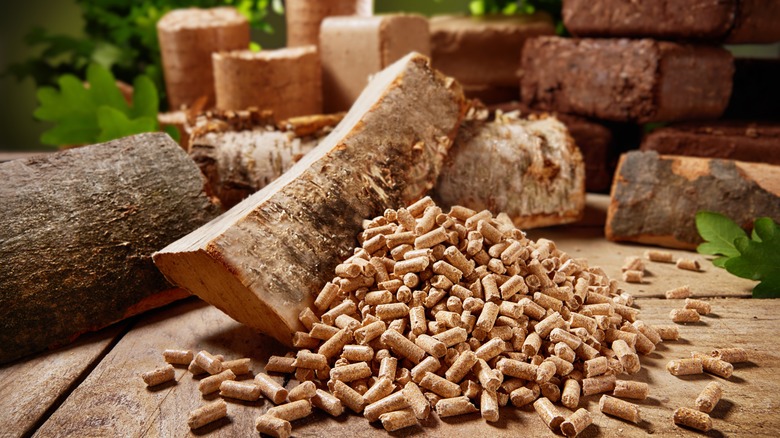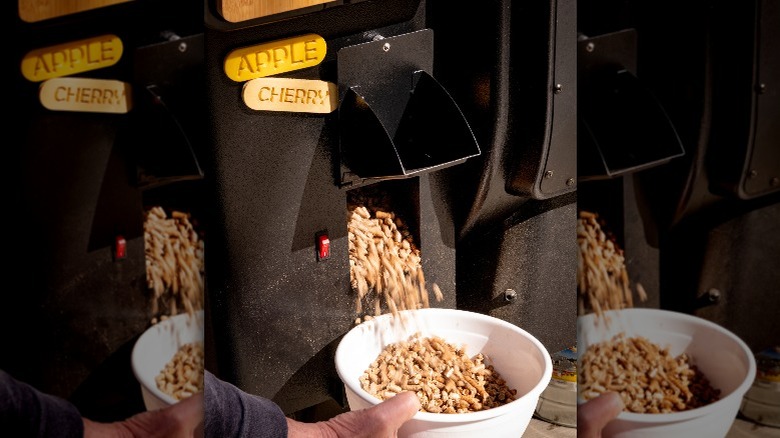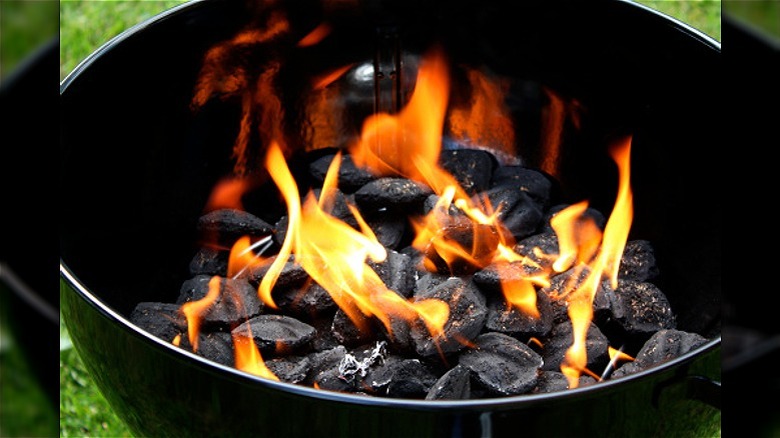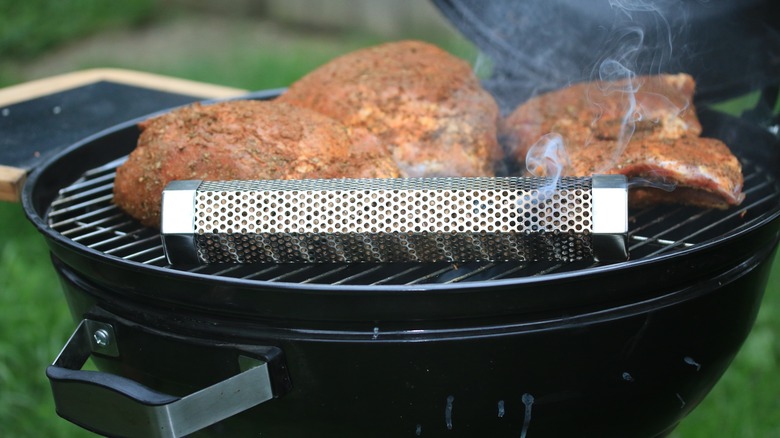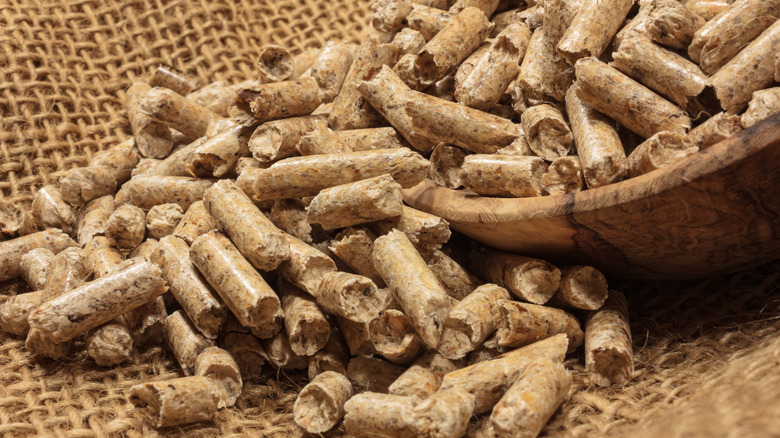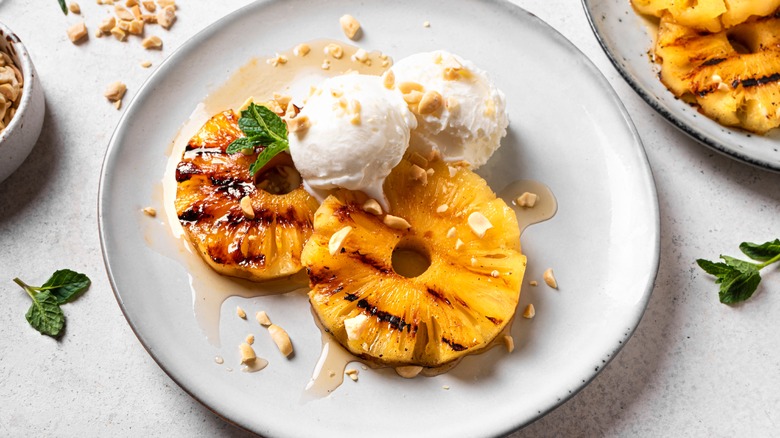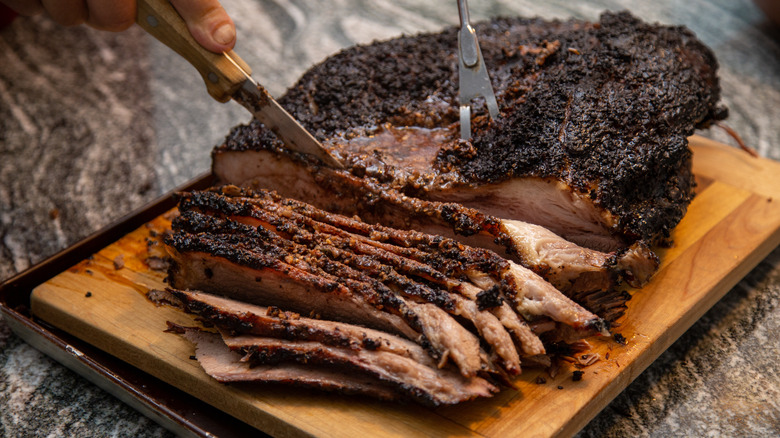14 Tips For Grilling With Wood Pellets, According To Expert Pitmasters
Wood pellet grilling has been around for a while but hasn't always been looked upon favorably. In recent years, pellet grills have become more popular in backyard barbecue circles, but some folks in the BBQ competition circuit still frown on their use. However, the simplicity and accuracy of the pellet grill has begun to win over even the most stubborn, hardcore barbecue pitmasters.
Eliminating one of the toughest obstacles of cooking over open flames, pellet grills take much of the challenge and risk out of fire management. Because of this, pellet grills level the grilling game for all types of barbecue enthusiasts — from beginners to experts. It gives outdoor cooks the chance to focus on creating the best food while concentrating on taste and tenderness. But though pellet grills are easy to use, there's still a lot to learn to master the art of smoking.
We contacted some of the top experts in the barbecue business to bring you the best tips for grilling with wood pellets. We reached out to Will Hair from the winning SmokeMasters BBQ team, which recently took home The Grand Championship from the SmokeSlam competition in Memphis, Tennessee. We also spoke with Christie Vanover, owner and pitmaster for team Girls Can Grill, and Rus Jones, owner and pitmaster for Smoky Ribs BBQ.
1. Use a pellet grill or smoker for best results
It might go without saying that a pellet grill for wood pellets would yield the best results, but there are several options for wood pellets, says Christie Vanover, and each yields different results. She explains that wood pellets can be a primary fuel source with a pellet grill or used with gas or charcoal grills to add smoky flavor. If you want the best out of your wood pellets, invest in a good pellet grill. A major benefit of using a pellet smoker, Rus Jones tells us, is how "grilling with pellets on a pellet grill frees up your time since it runs itself and requires very little attention."
Pellet grills are designed to feed the fire the exact number of pellets needed for producing the thin blue smoke barbecue enthusiasts look for, according to Will Hair. It's not uncommon for cooks new to pellet grilling to believe their pellet grill isn't producing enough smoke, but that's because they aren't witnessing a plume of thick white smoke, which, as Hair says, no one wants anyway. "Look at the smoke ring on your first brisket or pork butt. The results speak for themselves!" he exclaims.
Jones notes that newer pellet grills give you plenty of smoke, though older models may not. In this case, you can add more wood pellets to a smoke tube or box to provide you with more smoke.
2. Maintain a clean grill for a better cook
One of the biggest mistakes people make with a pellet grill, Rus Jones says, is not cleaning the ash out of the grill or fire pot. Failure to do so can lead to flame outs and may cause other issues. Christie Vanover agrees that cleaning your pellet grill is an important step to maintaining consistent temperatures for cooking. She recommends emptying the ash and cleaning the fire pot after every few cooks.
Though keeping your pellet grill clean can be a challenge, Will Hair has an unusual, but effective, suggestion to make the process easier: a vacuum cleaner. "I recommend a metal canister shop vac. Getting the leftover dust and debris out of the cook chamber ... is imperative for the continued optimal operation of your cooker," explains Hair. "A vacuum makes this process super simple." Another way to limit the amount of dust the wood pellets can generate is to use high-quality wood pellets that are less apt to just fall apart. This also reduces the need to sift wood pellets before loading them into the hopper.
3. Follow the manufacturer's instructions
Will Hair stresses the importance of understanding your pellet grill and paying attention to the manufacturer's instructions for heat-up and cool-down procedures. Preheating your pellet grill to the factory preset, recommended temperature helps the grill to operate at its optimal level of operation. "This allows the controller to better calibrate the temp you set and assists in keeping the dialed-in temps closer to your set point," Hair advises. "It also eliminates some of the temp swings that can happen if you simply switch your cooker on and set it to your desired temp."
Likewise, learning to properly cool down your pellet grill can help your grill last its maximum lifespan. Keeping the convection fan running can help dissipate heat safely and efficiently. "Instead of just switching the unit off," Hair explains, "or unplugging it when you're finished, this cool down allows the fire to burn out on its own." This process can help prevent a fire from the pellet hopper and reduce the risk of damaging your grill.
4. Learn the hot spots on your grill
A mistake people make when using a pellet grill, according to Christie Vanover, is not paying attention to your grill's temperature. Your pellet grill will not always cook evenly. She urges folks to learn the hot spots on your specific grill, noting that on a pellet grill, your grill grate is going to be a little hotter right over the fire pot. Once you've determined your hot versus cooler spots on the grill, you can take advantage of the 2-zone grilling method.
It can depend on the type of pellet grill you have as to where the hot spots are located, Vanover says. Hot spots can be found in the center or along the sides of your grill. She suggests an easy way to figure this out: "Place slices of bread or canned biscuits all around the grill grate. Cook them for a few minutes at 350 F degrees." The idea is to watch what pieces cook faster or even which ones burn. The pieces that char quicker indicate you've just found the hot spots on your pellet grill. This way, you don't find out the hard way by ruining your barbecue.
5. Source top-quality wood pellets
A common mistake, Will Hair says, that newcomers make when attempting to use wood pellets is getting the wrong kind of pellets. "Using low-quality pellets," he explains, is the fastest way to "[become] disillusioned with poor performance from your equipment." When you use a quality wood pellet, he assures you'll receive fantastic results and realize your pellet grill equipment works just fine. Personally, Hair makes sure to choose a quality brand of pellet, such as BBQ Delight and Royal Oak. These two brands focus on strict quality control during the manufacturing process. "When you open a bag of pellets from either of these manufacturers ... you are adding whole, unbroken, quality pellets that will only enhance the features of whatever pellet cooker you are utilizing."
Expert pitmasters only use the best, and Christie Vanover recommends Cowboy Charcoal & Hickory wood pellets to help you achieve an authentic charcoal flavor. Rus Jones' go-to for wood pellets is either B&B or Bear Mountain. Whatever brand you choose, make sure your wood pellets are made from quality wood and not full of fillers.
6. Keep at least 40 pounds of wood pellets on hand for each cook
"One of the worst things that can happen during a pellet cook is to run out of fuel," warns Will Hair. If you're using a pellet grill, it's crucial to ensure you have enough wood pellets on hand before you start cooking. If you run out of pellets during a cook, you'll have to reset the pellet grill, which could derail your cook. Resetting your cooker restarts the controller's learning process, Hair explains, which could increase your cook time by an additional 20 to 60 minutes. "Most meats will not survive that type of pause to the cooking process without negative side effects," says Hair.
Our expert pitmasters recommend having about 40 pounds (two 20-pound bags) of wood pellets ready to go before you begin any type of cook, especially for long cooks, such as when smoking brisket or pork shoulder. "I live by the rule, 'I'd rather have too much than not enough!'" Hair adds. But if you do find yourself without the right amount of wood pellets to complete your cook, your oven will work in a pinch. "Remove your food from the grill and transfer it to a pan in the oven," Christie Vanover advises. "Just set your oven to the same temperature as your grill."
7. Mix and match different wood pellet varieties for enhanced flavors
Two reasons to use wood pellets are for fuel and flavor. And one of the joys of using wood pellets is choosing your flavor of wood to enhance your food. Most foods can benefit from a blend of two or three different types of wood pellets, but Will Hair warns, "More than three is overkill, and you won't get the flavor you think you want."
It helps to know the different types of wood for smoking and grilling to get the barbecue flavor you desire, but you can also play around with the various types to find your personal favorite. All of our barbecue experts recommend hickory for beef and game meat, but nutwood like pecan and fruitwood such as cherry also pair well with these proteins. Milder proteins such as lamb, pork, and poultry benefit from equally mild wood like apple, pecan, and cherry. Seafood responds well with alder wood, but Hair suggests, "A sugar maple pellet is also a fantastic choice for thicker cuts such as tuna steaks or cod filets."
8. Combine wood and charcoal pellets for an authentic grilling flavor
One of the drawbacks to using a pellet grill is the lack of charcoal and its unique taste that it imparts on food — the taste most people often associate with barbecued food. But pellets for a pellet cooker have come a long way, and now you can find charcoal pellets to give you that authentic charcoal flavor for your barbecue. Charcoal pellets look a little different than wood pellets; they're black like charcoal briquettes. Christie Vanover warns that some pellet grills don't sense the use of charcoal pellets due to the darkened color and suggests checking with the pellet cooker manufacturer to ensure you don't run into any issues.
A benefit to using a pellet grill instead of a charcoal grill is simple convenience. You still get to have that charcoal essence infused into your food, but as Vanover points out, "You don't have to monitor the temperature as closely as you do for charcoal grills." Using charcoal pellets is one of Vanover's favorite ways to use a pellet cooker. She uses charcoal and wood pellets that are already combined and never feature binders or additives. But she's not alone; it's a popular choice among pitmasters.
Will Hair's go-to for smoking beef and pork is a 50/50 blend of charcoal pellets and hickory pellets. Meanwhile, he prefers a 50/50 blend of charcoal pellets and peach pellets for poultry and seafood.
9. Keep your cook simple
The pellet grill is easy to use, but there is an art to smoking, and Will Hair strongly suggests newbies keep it simple when starting out. He says, "New cooks tend to overthink the process with pellet grills. Specifically, do not overdo it when it comes to pellet flavors." Enjoy the process when you're choosing which wood flavors to burn with your favorite recipes — but go slow and become familiar with the various types before experimenting. Though there used to be few varieties to choose from, the many different choices could have your head spinning. Thankfully, as Hair mentions, "These days, companies have done the research, and the blends that work are readily available for purchase at your local BBQ store or the big box stores."
Just like you want to keep it simple with your choice of wood pellets, start simple with the food you grill until you're comfortable tackling more challenging recipes. Easy recipes like grilled chicken allow you to experiment with different wood pellets to see how they can change the taste of your grilled meat. Introduce yourself to charcoal pellets with an easy grilled corn on the cob recipe. Once you understand how these wood pellets affect your cook, you can graduate to more complex meals.
10. Add wood pellets to a charcoal grill later in the grilling process
Contribute more smoke to your charcoal grill by supplementing with wood pellets. There are a couple of different ways to do this: use a pellet tube or toss a handful of wood pellets onto your charcoal briquettes. If you add wood pellets right on top of the coals, Christie Vanover tells us that wood pellets burn rather fast, and your best bet is to use them during the last part of the cook. She puts wood pellets on top of coals right before she brushes sauce on her meat, so the smoke adheres to the sauce.
Will Hair agrees there's a science to adding wood pellets to charcoal grills. Unlike wood chips that can be soaked in water to slow burn time, wood pellets and water just don't mix, Hair notes. If you add wood pellets too soon to your charcoal, the pellets will burn long before it gives your food any flavor. If you add the pellets too late, your food won't absorb much of the smoke before it's ready to come off the grill. "I like to add pellets to a hot charcoal fire right before I add my protein," he says. "Adding them at this point allows my pellets to ignite, and the flavor is dispersed just as the meat is beginning to cook."
11. Use a pellet tube or box with a gas grill
You can take advantage of the many benefits wood pellets lend to your barbecue if you're using a gas grill; the process is just a little different. With a gas grill you'll need a pellet tube or smoke box in order to burn wood or charcoal pellets while you're grilling. These portable devices can be used with any type of grill since they sit on the grill grates above the heat source to produce smoke, but they work especially well with gas grills, Will Hair says.
Pellet tubes or boxes are easy to use: Fill the tube or box with your choice of wood pellets, light the pellets, and then blow the fire out so you're left with smoke. The purpose of the tube, Hair explains, is to contain the wood pellets and allow them to burn slowly. The tube is covered in holes for the smoke to escape, which then fills the gas grill chamber so smoke flavor is swirling among your gas-generated heat source. But the only way this handy barbecue tool works, explains Christie Vanover, is to "be sure to keep the lid closed while grilling to trap the smoke into the grill."
12. Store wood pellets in a temperature-controlled environment
Wood pellets are only going to help boost your barbecue if they remain in good shape. As long as you're using good quality wood pellets, you're pretty much burning straight wood without many binders and fillers, Will Hair tells us. And though wood pellets don't spoil in typical culinary fashion — they're not going to cause food poisoning if they're not stored properly — they will eventually deteriorate if you don't take care of them between cooks.
Our experts recommend storing wood pellets in an air-tight, sealed container in a temperature-controlled environment in order to keep the pellets dry and usable. Nothing will ruin wood pellets faster than being exposed to excess moisture or humidity since wet pellets will just dissolve. Christie Vanover warns, if you use wood pellets that are too moist, you could clog the auger — the area with the blade that moves pellets from the hopper to the fire pot. Unless you're an avid barbecuer like our experts, and as long as you store your wood pellets wisely, Hair says pellets can last up to a year with no negative effects.
13. Think beyond the usual barbecue fare and try smoking dessert
Almost any recipe you can think to cook with your stove or oven can be done on a grill; you just might need extra barbecue equipment to accomplish the task. Christie Vanover suggests using your pellet grill to make pies, cakes, and casseroles. She says, "They cook as consistently as an oven but add a kiss of smoke." Place an inverted pan on the upper rack. Then place your pie or cake pan on top of that to keep it elevated above your heat source. Vanover tells us, "This will prevent the bottom from burning."
Whether you grill fruit, cheese, or pies, wood pellets add a fruity or nutty complement to your dessert. Fruitwood such as apple and cherry pair well with dessert fare, but even a simple charcoal pellet brings a rich barbecue flavor to an otherwise sweet recipe. Will Hair prefers to use a stronger pellet when cold-smoking cheese, like hickory, pecan, or peach.
14. Have fun with your pellet grill
Grilling doesn't have to be all business. Will Hair encourages you to have fun with your pellet grill: "BBQ, like any other style of cooking, is an extension of you and your personal cooking preferences." Enjoy cooking outdoors, whether you're with friends or family or catering to a few or many. Hair stresses to make the moment yours and put everything you've got into making your food delicious, especially when choosing recipes and the wood pellet flavors that will complement them.
Hair feels we can all be the next "backyard Bobby Flay" because "pellet cookers are a fantastic way to enjoy the process — perfecting recipes without having to focus on the challenges of perfecting fire management." Stretch your grilling skills by smoking your next Thanksgiving turkey, beef tenderloin, or pork chops. Try grilled pineapple or peaches with cold-smoked cheese and add your personal flare to smoked desserts.
